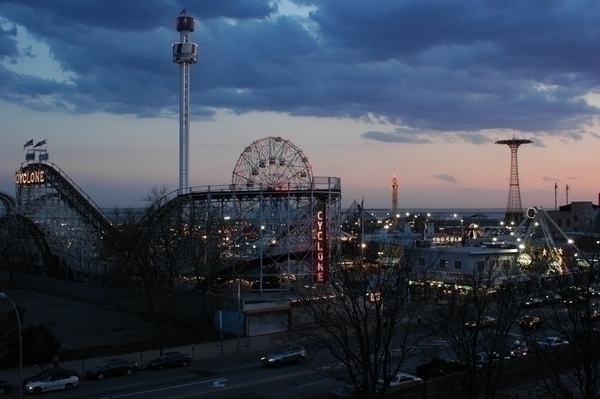Modern Coney

Lynn Hyman Butler, American, born 1953. The Girl with a Gun. From the series “Coney Island Kaleidoscope” ca. 1988. Cibachrome color print. sheet: 11 x 13 3/4 in. image: 9 x 13 1/4 in. Gift of Ilford Photo Corporation. 1991.59.6

Lynn Hyman Butler, American, born 1953. The Red Horse. From the series “Coney Island Kaleidoscope” ca. 1989. Cibachrome color print. sheet: 11 x 13 3/4 in. image: 9 x 13 1/4 in. Gift of Ilford Photo Corporation. 1991.59.3
In 1983, the not-for-profit corporation Coney Island USA was created to assist in rejuvenating Coney Island’s amusement life. It developed many of the programs that later generations of visitors recognize, such as the Mermaid Parade, Sideshows by the Seashore, and concerts on the boardwalk. Lynn Butler’s dynamic take on the site in her Coney Island Kaleidoscope series is a document of a gritty and still spectacular Coney Island from this period.
Sunset Over Coney Island, April 2006, Flatbush Gardener (from the Goodbye Coney Island? group on Flickr)
In 2006 the owners sold Astroland to a developer who had already assembled a large amount of land in Coney Island’s old amusement area. A short-term lease will allow them to reopen next summer, but it remains unclear whether the developer’s plan for towering hotels, shops, restaurants, movie theaters, and high-tech entertainment will be accepted or rebuffed by city authorities, who proposed their own scheme last fall.
Mermaid Parade Hula Hoopers, drfardook (from the Goodbye Coney Island? group on Flickr)
In the past few years, attempts to revitalize Coney Island have increased; KeySpan Park and the new Stillwell Avenue subway station are the most obvious examples. While many agree that rejuvenation is necessary, voices have been raised against the prospect of turning Coney Island into a gentrified enclave for the well-off.
break dance!, ranjit (from the Goodbye Coney Island? group on Flickr)
New York City’s creation of a Coney Island Development Corporation in 2003 brought together city officials as well as local business and community leaders. This initiative indicated awareness of the importance of caring for the area’s traditional qualities and of keeping it available to a diverse audience while providing a wide-ranging plan for economic development that would include a year-round amusement district as well as many new residential opportunities. At this moment, it is uncertain what the result of these efforts will be.

Patrick Amsellem is the Associate Curator of Photography at the Brooklyn Museum. Formerly a curator at the Rooseum Center for Contemporary Art in Malmö, Sweden, Patrick organized the first Swedish exhibition of the work of Andreas Gursky and was part of the curatorial team that produced a major series of exhibitions under the leadership of Lars Nittve. He has written about art for Stockholm’s major newspaper Svenska Dagbladet and was also a critic for the Swedish daily newspaper Kvällposten and for Swedish Public Radio. Patrick has taught at New York University and is the author of several exhibition catalogues. He received a Ph.D. in Art History from New York University’s Institute of Fine Arts.



